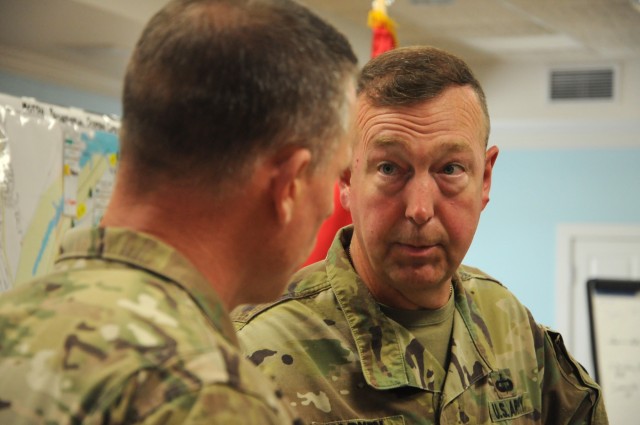Truckers hauled the first 2,000 tons of fill material into the Military Ocean Terminal Sunny Point, N.C., Sept. 25, less than one week after the U.S. Army Corps of Engineers put boots on the ground here.
Hurricane Florence battered MOTSU with piercing winds and destructive flooding Sept. 15, leaving the strategically critical logistics installation with eroded rail lines, washed out roads, and significant wharf damage.
As the key ammunition shipping point on the Atlantic coast for U.S. forces worldwide, the MOTSU recovery quickly became a Defense Department priority, and the Corps' Savannah District was chosen to lead the effort.
In less than a week Col. Daniel Hibner, commander of the Savannah District, assembled a team of experts to assess damage and repair critical infrastructure. He tapped into the Corps' vast network of expertise, including structural, hydraulic and civil engineers, to form his team.
Professionals from six districts across the nation converged on MOTSU within two days to assess the damage and execute construction contracts, the first of which is scheduled to begin as early as Sept. 29.
"No one has ever executed a process like this in less than a week," said Tracy Hendren, Savannah District Engineer Division Chief. He added that the normal time to organize comparable efforts is typically measured in weeks, if not much longer.
But Hibner didn't stop with Corps experts and contracts. He made a call that got dirt moving on Day 3. This came in the form of the 27th Airborne Combat Engineer Battalion at Fort Bragg, North Carolina. The battalion sent 93 Soldiers to support this rapidly forming task force and they were on site less than 12 hours from the execution order.
The arrangement for a battalion was the first of its kind, and the result was swift execution and taxpayer savings.
"We coupled a combat engineer battalion that's equipped to provide expeditious construction capability through airborne operations, with a district able to execute massive construction projects at installations throughout the world and critical civil works projects that support the nation, such as the Hoover Dam," said Hibner. "It is the first time we've ever task organized a combat engineer battalion under a U.S. Army Corps of Engineers brigade level district command. It's working incredibly well."
And it's proved to be a powerful combination.
"We're delivering in ways we haven't been able to deliver before," he said.
Since Sept. 19 the 161st Engineer Support Company, Airborne, has had a team of trained Soldiers repairing critical perimeter roads, berms and other areas where flooding and erosion disrupted the infrastructure.
Additionally, the 57th Sapper Company, (Combat, Airborne, Rough Terrain) also deployed to MOTSU. Sappers are specialized airborne Soldiers trained to breach terrain obstacles, among other roles.
Hibner put the Sappers to work clearing dozens of downed trees that damaged perimeter fencing and blocked roads and railways on MOTSU. They are currently averaging about 30 tree removals daily, according to 1st Lt. Adam Yates, 2nd Platoon leader. Normally Sappers use demolition to clear terrain, but since MOTSU is an ammunition port, explosives were out of the question.
So the Sappers resorted to hand tools.
"I'm real proud of these guys," said Yates. "We've covered a lot of miles; cut down a lot of trees to get this place back up and running."
Yates said they've been cutting so many trees they wore out the blades on 12 chain saws. And since motorized saws are in such demand after the storm, resupply was delayed. But this didn't slow down the Sappers.
"When the chain saws and other power tools wore out," said Hibner, "they took a bunch of hand saws and axes went at it like Samurais."
See a video of them in action: http://ow.ly/HLf130lYZjb.
"The energy the 27th Engineer Battalion has brought to this recovery is incredible," said Hibner. "This relationship exponentially provides an operation like MOTSU, which is critically important to military operations throughout the world, with the needed resilience to rapidly recover from a disaster like Hurricane Florence."
The rough-order cost estimate of the operation is approximately $27 million.
MOTSU is the largest ammunition port in the nation and is the Defense Department's primary East Coast deep-water ammunition shipping point. Roughly 85 percent of the ammunition used in U.S. combat operations is processed through the wharves on the installation, according to Maj. Gen. Stephen Farmen, Commanding General of U.S. Army Military Surface Deployment and Distribution Command.
"Without ammo, you don't have the lethal element needed [in war]," he said.
Hibner said he is impressed by the ability and speed of the U.S. Army Corps of Engineers to team up with the U.S. Army Forces Command and mass resources in response to an emergency on an Army installation.
"The foundation of that rests in the remarkable expertise that is resident in our total-Army force," he said.














Social Sharing